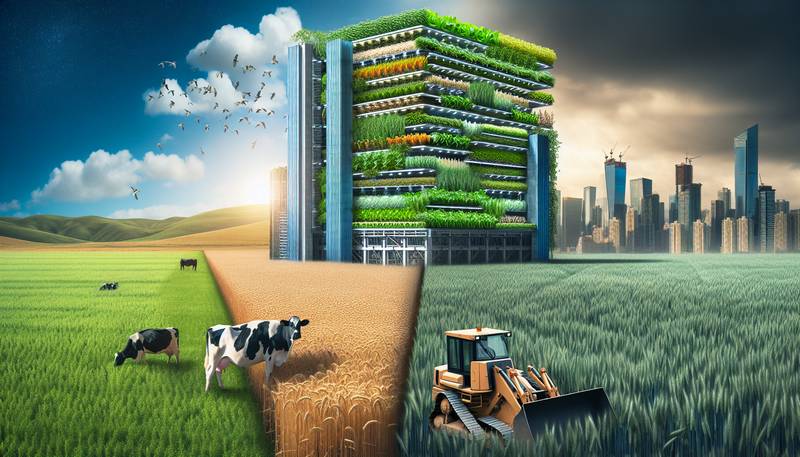Vertical Farming: Future of Urban Food Supply

Waving Goodbye to Traditional AgriculturePicture it. A verdant landscape stretching out as far as the eye can see, the pastoral calm punctuated only by the occasional moo of a cow and the gentle rustling of the wind through the wheat fields. If you can picture it, hang on to that mental image, because those days may soon be bulldozed over by the relentless march of progress. As we collectively hurdle towards a population of 9 billion humans by the year 2050, the age-old art of growing our own food may be usurped by a newfangled and space-age solution: vertical farming.A Lofty Idea: The Birth of Vertical FarmingTraditional agriculture has been a cornerstone of our existence, but it's not without its faults. Enter Dr. Dickson Despommier, a thought-leader and innovator who wasn't content to let a good idea remain earthbound. In the early 2000s, he and his students at Columbia University pondered the question: "With limited space for farming, how can we feed a rapidly growing population?" The answer, they believed, was to take agriculture to new heights – literally.Earthen fields would be replaced by towering structures, where plants are nurtured hydroponically, using mineral nutrient solutions rather than soil. These "farmscrapers" would produce food at a scale unseen in human history, dwarfing the harvests of even the most fertile acres of farmland. With their novel concept, Dr. Despommier and his students sparked a revolution in agriculture that has the potential to change the way we grow and consume food forever.Reaping the Benefits of the Vertical RevolutionAt first glance, vertical farming may seem like an outlandish and impractical concept. But delve deeper into the concept, and you will find a cornucopia of benefits that traditional farming simply cannot match:- Year-round harvest: Vertical farms are not at the mercy of the seasons or the weather, enabling farmers to grow crops all year round.
- Reduced water consumption: Hydroponics and aeroponics use far less water than traditional farming, with some estimates suggesting that vertical farms use up to 95% less water.
- No pesticides or herbicides: Vertical farms are sealed environments, protecting plants from pests and diseases without the need for harmful chemicals.
- Reduced food miles: Vertical farms can be built in urban areas, bringing food production closer to consumers and reducing the pollution and carbon emissions associated with long-distance transportation.
- Increased food security: By growing food locally, vertical farming can help insulate communities from the risks of global food shortages and price fluctuations.
Scaling the Skyscrapers of SustainabilityMany vertical farming enthusiasts envision a world where every city has its own vertical farm, supplying residents with fresh, locally-grown produce. And while we're not quite there yet, there are a number of vertical farms already in operation around the globe – from New Jersey to Japan, Sweden to Singapore.One of the leaders in this burgeoning industry is AeroFarms, a company that has transformed a disused steel mill in Newark, New Jersey, into a 69,000-square-foot vertical farm. Inside this urban agricultural oasis, thousands of LED lights bathe rows of leafy greens in a soothing pink glow, while an aeroponic system provides the plants with a fine mist of water and nutrients. The result is a stunningly efficient food production system that can yield up to 390 times more produce per square foot than traditional farming.In a nod to the cyclical nature of life, even the ruins of abandoned buildings can be reborn as vertical farms. Take the case of Plantagon, a Swedish vertical farming pioneer that has transformed an old, derelict industrial building in Linköping into a thriving food factory. Dubbed the "World Food Building," this impressive structure houses a spiraling vertical farm that produces vegetables without using any soil or pesticides. The building even has a built-in climate system that ensures optimal growing conditions year-round, regardless of the fickle whims of Mother Nature.The VertiCult of Personality: Embracing the Urban JungleOf course, progress rarely comes without its share of critics and naysayers. Some argue that vertical farming is too energy-intensive, relying on artificial lighting and climate control systems that consume vast amounts of electricity. Others question the cost-effectiveness of vertical farms, comparing their per-acre yields to the bounty of traditional farms.While these concerns are not without merit, the potential benefits of vertical farming are difficult to ignore. As our world becomes increasingly urbanized, it's vital that we find innovative ways to grow our food in ways that are efficient, sustainable, and environmentally responsible. Vertical farming may not be a perfect solution, but it's a promising step toward a greener, more bountiful future.So next time you find yourself in the heart of a concrete jungle, surrounded by buildings that scrape the sky, take a moment to ponder the possibilities. Perhaps, in the not-too-distant future, those skyscrapers could become farmscrapers – and the future of urban food supply will be, quite literally, looking up.
|
|







